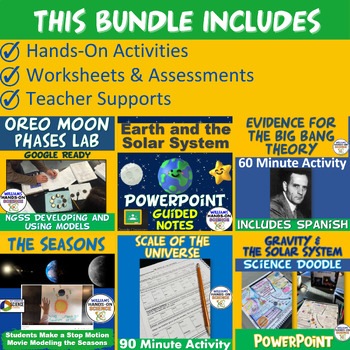NGSS Astronomy Unit Bundle: PowerPoint Labs Guided Notes Activities Assessment
- Zip

Products in this Bundle (17)
showing 1-5 of 17 products
Description
These activities aren’t just you’re ordinary everyday fill in the blank rote worksheets. These are student centered, challenging, hands-on, engaging activities that will wow and motivate even some of the most reluctant learners. I’ve taught, tweaked and improved these products since 2000. I bundled ALL of my Astronomy products and even some PowerPoints and Prezis that include some concepts not mentioned below, but the main purpose of this product is a middle school and/or High School Astronomy unit. However, many of the activities can be modified for below middle school. The unit also includes 6 Claim Evidence Reasoning CER graphic organizers with an accompanying current event article to stay up to date on the latest astronomy discoveries!
These resources are also included in larger bundles below:
TERMS OF USE
• All rights reserved by Williams Hands On Science, Inc.
• This product is to be used by the original purchaser only.
• Intended for classroom and personal use only.
• Copying for more than one teacher, classroom, department, school, or school system is prohibited.
• This product may not be distributed or displayed digitally for public view.
• Failure to comply is a copyright infringement and a violation of the Digital Millennium Copyright Act (DMCA).
If there are any errors or questions, please contact me through TpT or email me at:
williamshandsonscience@gmail.com
Thank you for taking a look!
Please follow me on TpT for new products and check me out on Instagram for my products in action!
https://www.instagram.com/williams_hands_on_science/
THIS PRODUCT INCLUDES THE FOLLOWING CONCEPTS:
Astronomy
Earth’s axis
Rotation
Revolution
Orbit
The Earth’s Seasons
Summer Solstice
Equinox
Vernal/Spring Equinox
Autumnal/Fall Equinox
Phases of the Moon
Eclipses
Solar eclipse
Lunar eclipse
Tides
Spring Tides
Neap tides
Structure of the Moon
The Sun
The Sun’s interior
The Sun’s Surface
Solar Flares
Waves
Universe
Galaxies
Milky Way
Andromeda
Spiral Galaxies
Dwarf Galaxies
Virgo Supercluster
Local Group
Solar System
Light-Years





